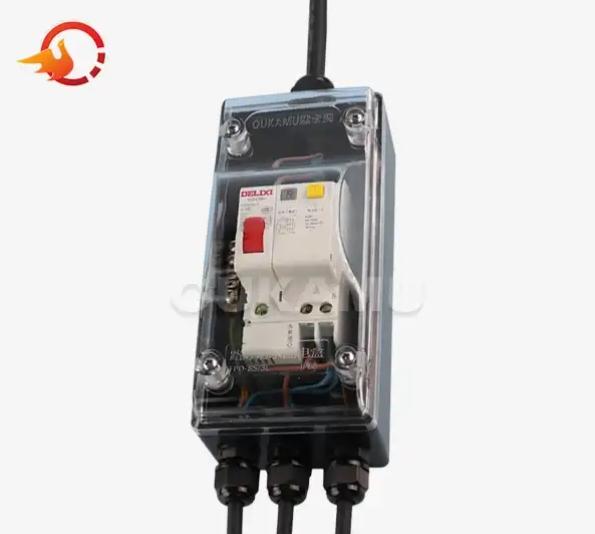Low voltage lighting is becoming an increasingly popular choice for both residential and commercial applications due to its energy efficiency, versatility, and safety advantages. Central to the effective operation of these systems is the low voltage lighting distribution box, which plays a crucial role in managing and distributing electrical power to different parts of the lighting system. With rapid technological advancements, innovations in distribution boxes are setting the stage for smarter, more efficient, and safer lighting solutions.
In this blog post, OUKAMU will explore how distribution box innovations are shaping the future of low voltage lighting. We will address key questions and emerging trends in this field, as well as provide insights into how OUKAMU's new Branch Cable technology is contributing to these advancements.
1. What Is a Low Voltage Lighting Distribution Box and Why Is It Important?
A low voltage lighting distribution box serves as the central hub for managing and distributing power to the various lighting circuits in a system. It ensures that electrical power is supplied safely and efficiently to each light fixture, while also offering protections against overloads and short circuits. In many lighting setups, particularly those in commercial and industrial spaces, the distribution box can handle multiple circuits, allowing for separate control over different areas of the building.
The Role of Distribution Boxes in Low Voltage Systems
At its core, the distribution box is designed to reduce electrical hazards, minimize energy loss, and enable streamlined control of lighting systems. The low voltage nature of these systems (typically operating at 12V to 24V) means that they are much safer to handle compared to traditional high voltage systems. This is especially critical in environments where electrical safety is a primary concern, such as residential spaces, hotels, and hospitals.
Innovations in the design and functionality of these distribution boxes have made it easier for installers to manage complex wiring setups, while also enhancing the flexibility and scalability of the lighting systems. The integration of newer technologies, like OUKAMU’s Branch Cable system, has further transformed how these systems are designed and implemented, making installation faster and more efficient.
2. How Can Innovations in Low Voltage Lighting Distribution Boxes Improve Energy Efficiency?
Energy efficiency is one of the biggest drivers behind the adoption of low voltage lighting systems. Distribution boxes are pivotal in this process because they directly affect how electrical power is routed and consumed by the entire system.
Minimizing Energy Loss Through Smart Distribution
Older distribution boxes were often designed with simpler wiring setups and lacked advanced features that could optimize energy usage. Today, however, innovations in distribution box technology have made it possible to reduce energy loss significantly. For instance, advanced materials like copper and high-grade aluminum are used to improve conductivity and reduce resistance, leading to lower energy consumption.
Smart Features for Improved Control
The integration of smart technology into low voltage lighting distribution boxes is another key factor in improving energy efficiency. These smart distribution boxes can be connected to building management systems (BMS) or even controlled remotely through smartphone apps. This allows users to monitor and adjust their lighting usage based on real-time data, which helps to reduce waste and ensure that lighting is only used when necessary.
For example, motion sensors, timers, and dimming controls can be incorporated into distribution boxes, allowing lights to automatically adjust based on occupancy or ambient light levels. Such innovations make it easier for both residential and commercial buildings to optimize energy consumption while maintaining the desired lighting levels.
3. How Do Low Voltage Lighting Distribution Boxes Enhance Safety?
One of the most significant benefits of low voltage lighting systems is their enhanced safety compared to high voltage setups. Distribution boxes play a critical role in ensuring that safety standards are met and that the system operates reliably without posing risks to users.
Protection Against Overloading and Short Circuits
Low voltage distribution boxes come equipped with various protection mechanisms, such as circuit breakers, fuses, and surge protectors, which help safeguard the entire system from electrical faults. These components automatically disconnect power in the event of an overload or short circuit, preventing potential damage to the wiring or fixtures and reducing the risk of fires or electric shocks.
Moreover, many modern distribution boxes feature advanced circuit protection that is designed to handle higher load capacities, which is particularly useful in industrial or commercial lighting systems where the demand for electricity may fluctuate. Such systems can be equipped with circuit breakers that are specifically designed for low voltage circuits, ensuring maximum protection without unnecessary interruptions to the lighting service.
Fire Prevention and Reduced Electrical Hazards
Since low voltage systems use less power, the risk of heat buildup is much lower compared to high voltage systems. Innovations in the materials used in distribution boxes, such as fire-resistant plastics and metals, further reduce the likelihood of electrical fires. Proper installation and maintenance of these boxes also help to prevent common electrical issues, such as faulty connections or exposed wires, which can lead to dangerous short circuits.
4. What Are the Benefits of OUKAMU’s Branch Cable Technology for Low Voltage Lighting Distribution Boxes?
OUKAMU’s Branch Cable technology is one of the most exciting innovations in the low voltage lighting sector. This patented solution enables the connection of multiple cables to a single source using a single branch point, greatly simplifying the wiring process and reducing the amount of materials needed.
Simplified Installation and Maintenance
The Branch Cable system eliminates the need for multiple splicing points and minimizes the complexity of connecting various circuits within a distribution box. This not only makes installation faster and more efficient but also reduces the chance of installation errors. By consolidating wiring into fewer, more manageable connections, it also makes ongoing maintenance and troubleshooting much easier.
Increased Flexibility and Scalability
In the past, expanding or modifying a low voltage lighting system often required significant rewiring and labor-intensive changes to the distribution box. With the Branch Cable system, however, it is much easier to add or remove lighting fixtures and circuits as needed. This makes the system more adaptable to changing lighting needs, particularly in large commercial or industrial spaces where the layout may evolve over time.
Furthermore, the Branch Cable system supports the growing demand for energy-efficient lighting setups by ensuring minimal energy loss and reducing the need for bulky connections. The simplified design also means that fewer cables are needed, contributing to a cleaner, more organized setup that looks and performs better over the long term.
5. What Are the Future Trends in Low Voltage Lighting Distribution Box Design?
As the demand for energy-efficient and sustainable lighting solutions grows, we can expect continued innovation in low voltage lighting distribution boxes. The future of these systems will likely focus on further improvements in energy efficiency, safety, and integration with smart technologies.
Integration with IoT and Smart Building Systems
One of the biggest trends in low voltage lighting is the integration of Internet of Things (IoT) capabilities. Distribution boxes will become even smarter, with built-in sensors and communication technologies that allow them to communicate directly with other devices in a smart building ecosystem. This could include automatic adjustments based on environmental factors or the ability to remotely control the lighting system via a mobile app.
Greater Customization and User Control
As more people seek personalized control over their lighting systems, manufacturers will continue to innovate to offer customizable features. Future distribution boxes could allow for more granular control over individual lights, zones, and even color temperatures, enhancing the user experience and optimizing lighting for various activities.
Sustainability and Eco-Friendly Materials
In response to increasing concerns about environmental impact, future low voltage lighting distribution boxes will likely be designed with sustainability in mind. This includes using eco-friendly materials, reducing packaging waste, and implementing energy-efficient features. Innovations in energy storage and management could also lead to the development of distribution boxes that help store surplus energy for later use, further promoting sustainability.
Conclusion
The low voltage lighting industry is undergoing rapid transformation, driven by advancements in distribution box technology. Innovations in energy efficiency, safety, and smart features are making these systems more powerful and adaptable than ever before. With companies like OUKAMU leading the way with groundbreaking solutions such as the Branch Cable system, the future of low voltage lighting distribution boxes looks brighter than ever.
For more information about how OUKAMU’s technologies can revolutionize your low voltage lighting system, feel free to contact us at [email protected].
References:
- Low Voltage Lighting Systems: Benefits and Applications - Energy.gov
- Smart Lighting Solutions for the Future - Green Building Alliance
- The Evolution of Lighting Distribution Boxes - Electrical Engineering Review
- How OUKAMU’s Branch Cable Technology is Changing the Wiring Industry - OUKAMU Official Website
- Energy Efficiency in Low Voltage Lighting - Energy Star
- Best Practices for Installing Low Voltage Lighting Systems - Wiring & Electrical Systems Journal
- The Role of Distribution Boxes in Smart Building Infrastructure - IoT Energy Journal
- Electrical Safety Standards for Low Voltage Systems - National Electrical Code (NEC)
- Low Voltage Lighting Market Trends - Global Market Insights Report
- Fire Safety in Low Voltage Wiring - National Fire Protection Association (NFPA)






